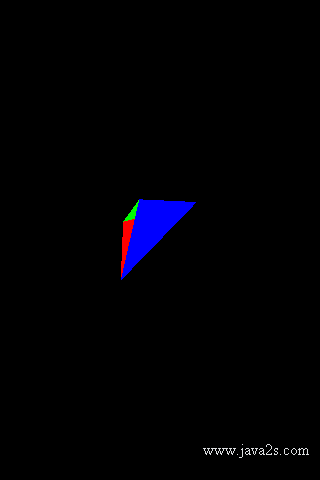Pyramid
Description
The following code shows how to create pyramid.
Example
Main Activity Java code
package com.java2s.myapplication3.app;
import java.nio.ByteBuffer;
import java.nio.ByteOrder;
import java.nio.FloatBuffer;
// ww w . java2s. c o m
import javax.microedition.khronos.opengles.GL10;
import javax.microedition.khronos.egl.EGLConfig;
import android.app.Activity;
import android.opengl.GLSurfaceView;
import android.opengl.GLSurfaceView.Renderer;
import android.opengl.GLU;
import android.os.Bundle;
import android.util.Log;
import android.view.Window;
import android.view.WindowManager;
public class MainActivity extends Activity {
private GLSurfaceView glView;
private ColouredPyramid pyramid;
@Override
public void onCreate(Bundle savedInstanceState) {
super.onCreate(savedInstanceState);
requestWindowFeature(Window.FEATURE_NO_TITLE);
getWindow().setFlags(WindowManager.LayoutParams.FLAG_FULLSCREEN, WindowManager.LayoutParams.FLAG_FULLSCREEN);
glView = new GLSurfaceView(this);
glView.setRenderer(new MyOpenGLRenderer());
setContentView(glView);
}
class MyOpenGLRenderer implements Renderer {
@Override
public void onSurfaceChanged(GL10 gl, int width, int height) {
gl.glViewport(0, 0, width, height);
gl.glMatrixMode(GL10.GL_PROJECTION);
gl.glLoadIdentity();
GLU.gluPerspective(gl, 45.0f, (float) width / (float) height, 0.1f, 100.0f);
gl.glMatrixMode(GL10.GL_MODELVIEW);
gl.glLoadIdentity();
}
@Override
public void onSurfaceCreated(GL10 gl, EGLConfig config) {
pyramid = new ColouredPyramid();
}
@Override
public void onDrawFrame(GL10 gl) {
gl.glClearColor(0.0f, 0.0f, 0.0f, 1f);
gl.glClear(GL10.GL_COLOR_BUFFER_BIT);
gl.glLoadIdentity();
gl.glTranslatef(0.0f, 0.0f, -10.0f);
pyramid.draw(gl);
}
}
}
/**
* @author tamas
*
*/
class ColouredPyramid {
private FloatBuffer vertexBuffer;
private static final int VERTEX_SIZE = (3 + 4) * 4;
private float vertices[] = {
0.0f, 1.0f, 0.0f, 1, 0, 0, 1, // V1 - red
-1.0f, 0.0f, 0.0f, 1, 0, 0, 1, // V2 - red
0.0f, 0.0f, -1.0f, 1, 0, 0, 1, // V3 - red
0.0f, 1.0f, 0.0f, 0, 1, 0, 1, // V1 - green
0.0f, 0.0f, -1.0f, 0, 1, 0, 1, // V3 - green
1.0f, 0.0f, 0.0f, 0, 1, 0, 1, // V4 - green
0.0f, 1.0f, 0.0f, 0, 0, 1, 1, // V1 - blue
1.0f, 0.0f, 0.0f, 0, 0, 1, 1, // V4 - blue
-1.0f, 0.0f, 0.0f, 0, 0, 1, 1, // V2 - blue
};
private float rotation = 0.1f;
public ColouredPyramid() {
ByteBuffer byteBuffer = ByteBuffer.allocateDirect(ColouredPyramid.VERTEX_SIZE * 3 * 4);
byteBuffer.order(ByteOrder.nativeOrder());
vertexBuffer = byteBuffer.asFloatBuffer();
vertexBuffer.put(vertices);
vertexBuffer.flip();
}
public void draw(GL10 gl) {
rotation += 1.0f;
gl.glRotatef(rotation, 1f, 1f, 1f);
gl.glEnableClientState(GL10.GL_VERTEX_ARRAY);
gl.glEnableClientState(GL10.GL_COLOR_ARRAY);
vertexBuffer.position(0);
gl.glVertexPointer(3, GL10.GL_FLOAT, ColouredPyramid.VERTEX_SIZE, vertexBuffer);
vertexBuffer.position(3);
gl.glColorPointer(4, GL10.GL_FLOAT, ColouredPyramid.VERTEX_SIZE, vertexBuffer);
gl.glDrawArrays(GL10.GL_TRIANGLES, 0, 3 * 3);
gl.glDisableClientState(GL10.GL_VERTEX_ARRAY);
gl.glDisableClientState(GL10.GL_COLOR_ARRAY);
}
}
